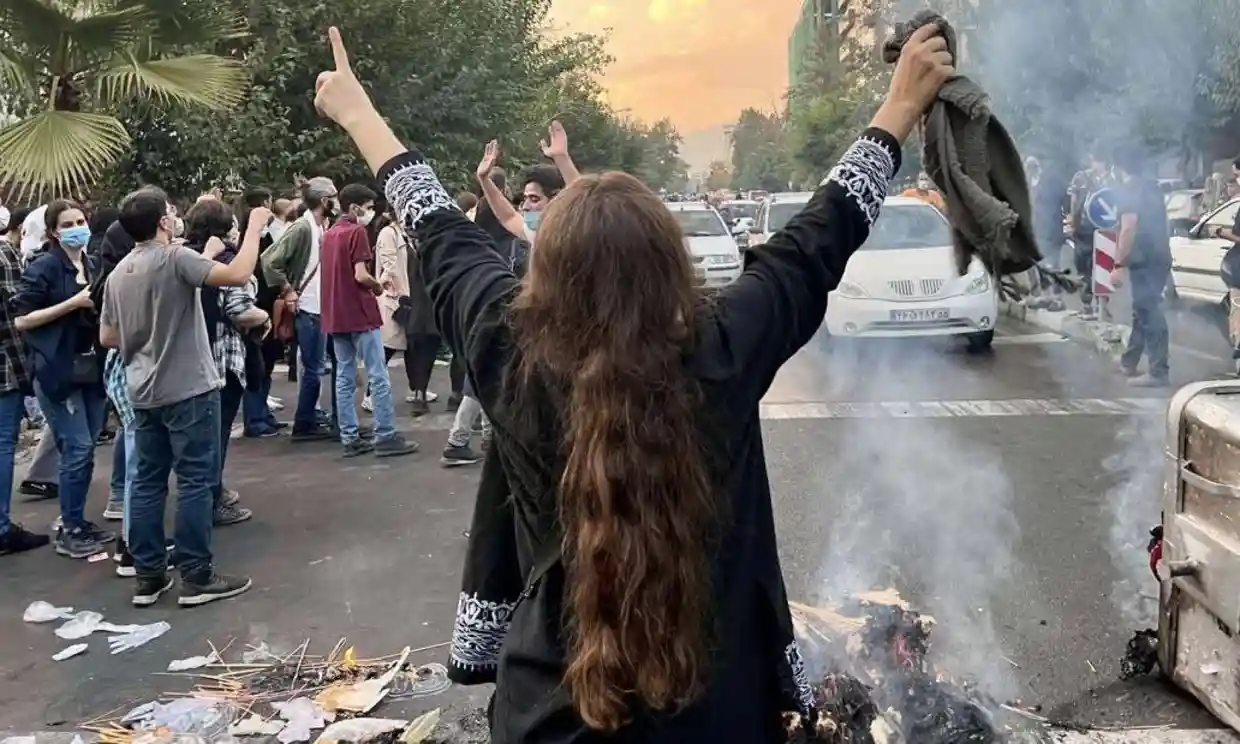What started as protests against the mandatory veil in Iran have transpired to popular protests across the country demanding freedoms and accountability.
Protests in Iran have entered their fifth week, shaking the streets of the country in response to the death in police custody of 22-year-old Kurdish Iranian Mahsa (Zhina) Amini on 16 September.
Amini was visiting Tehran when she was arrested by morality police who took issue with the way she had covered her hair. While the police maintain she died of natural causes, her family say she was tortured and killed.
“During the journey to the police station she was tortured and insulted,” Amini’s cousin Erfan Mortezaei told Sky News. “She suffered a concussion from a blow to the head. There is a report from Kasra hospital [in Tehran] that says effectively by the time she reached the hospital she was already dead from a medical point of view.”
Much has unraveled since September, in which demonstrators blamed Iran’s so-called ‘morality police’ for the death of Amini. What started as protests against the mandatory veil as ordered by the government of Iran, have transpired to popular protests across the country demanding more freedoms and accountability, protests internationally by diaspora groups as well as notable events such as Iranian athlete, Elnaz Rekabi competing without a headscarf at the Women’s Boulder & Lead Final during the IFSC Climbing Asian Championships in Seoul, South Korea.
At the beginning, Ava*, an Iranian student in Qatar who chose to remain anonymous, was happy to see the women in her home-country demanding justice, however after the violent repression of protests and the daily death toll of protestors, she is now terrified and worried.
“I have lost family members to this government before. I know how awful it feels, I know how it affects one’s identity knowing your own government is killing your own people in your own motherland,” she told Doha News, stressing that the death toll and number of detained individuals is likely to be higher than expected.
Iran Human Rights, a Norway-based group, has said at least 201 people, including 23 children, have been killed by security forces. The highest number of killings occurred in Sistan and Baluchistan province with half the recorded number, said the Norway-based Iran Human Rights in a statement on 8th October.
Protests in Iran have spread across more than 46 Iranian cities, towns and villages, and have been met with internet shutdowns and violent repression.
Hundreds of high school girls and university students were seen participating in protests in dozens of cities across the country over the last two weeks, according to videos posted on social media, despite the use of tear gas, clubs, and frequently live ammunition by security forces.
Iranian authorities have denied that live bullets have been used.
A video posted on Twitter by the widely-followed activist 1500tasvir showed security forces armed with clubs attacking students at a high school in Tehran.
In another video, a man shouted “don’t hit my wife, she is pregnant,” while trying to protect her from riot police in the city of Rafsanjan.
A video shared by Twitter account Mamlekate, which has more than 150,000 followers, showed security forces chasing dozens of school girls in the city of Bandar Abbas. Social media posts said shops were closed in several cities after activists called for a mass strike.
The hashtag “#IranRevolution” has now been trending for over a week on Twitter, with increasingly more Iranians, pundits and media outlets adding their voices to the upheaval, taking place both on ground and online.
Despite efforts to stop Iranians from accessing apps such as Instagram and WhatsApp, videos of people allegedly killed during the protests have been spreading on social media.
‘This is not just about the hijab’
Some female protesters have removed and burned their hijabs in the rallies and cut off their hair as a symbol of protest.
Following this, social media has become an avenue for discussions, with people calling for bans on the hijab while many Iranians, Muslims, and other scholars make it clear that the protests are against political and religious authoritarianism rather than religion.
Iranian-American activist Hoda Katebi tweeted: “The protests have nothing to with Islam and everything to do with a government that uses what it can to maintain power like the US using race and capitalism or France using secularism.” Criticising both the pre-1979 Pahlavi royal dictatorship in which Reza Shah Pahlavi, the then ruler of Iran, banned traditional Islamic veils and headscarves in 1936, as well as the post-1979 Islamic Republic which declared the veil mandatory along with a strictly enforced modest dress code.
“Although the spark of the movement was Mahsa Amini, this is so much more than that,” Laleh*, an Iranian resident in Qatar who prefers to remain anonymous told Doha News, stressing that the current movement represents broader social, political and economic concerns.
“The protests are about women fighting for the right to live, the right to make their own decisions, the right to express themselves (freedom of speech), having a normal economy that is unaffected by sanctions, stopping gender segregation, whether it’s in schools, work environments, or anywhere in the society. This movement is about everyone we’ve lost to this regime.”
Since the 1979 Islamic Revolution, women in Iran have been required to wear the hijab, and the morality police are tasked with upholding this among other restrictions. Recent criticism of the regime has focused on how it treats young women in particular.
“There are many types of Iranian women – they all have their own personal thoughts and agency -they all have their different grievances, and they don’t all agree on the issues at hand. But Iranian women have always been at the forefront of change in the country,” Laleh told Doha News, stressing that the ongoing protests are part of a wider history.
In 2017, dozens of women protested by removing their headscarves with popular protests at the time also filing the streets in response to the economic crisis that had hit the country, of which various experts have claimed were exacerbated by Western sanctions related to Iran’s nuclear programme.
“I’m frustrated that no one is talking about sanctions and [how] the way the West has treated Iran for four decades has contributed to all of this,” Laleh added.
“If you are not Iranian, you are not in a position to criticise or understand Iran in isolation from what the West has been doing to Iran for four decades. The rest of the criticism and decisions should be left to Iranians and it does not help the cause when there is massive Western hijacking of it.”
At the start of the ongoing protests, the Biden administration sanctioned Iran’s so-called “morality police” for the abuses and violence against Iranian women and protesters.
Sanctions have been imposed on Iran since 1979, since the succession of the government lead by Ayatollah Khomeini.
The overwhelming majority of sanctions have been imposed by the United States, though other entities such as the European Union, Australia and Canada also have a history of blacklisting Iran.
Since former US President Donald Trump pulled out of the Iran nuclear deal in 2015, various sectors of the Iranian economy have been under heavy US sanctions.
Certain reports have detailed how the sanctions on Iran only disadvantage Iranians, causing food and medicine shortages.
A recent United Nations report found that the US sanctions have led to the deaths of patients with rare diseases, as they block the supply of life-saving medicines and medical equipment required to treat certain types of cancer, thalassemia, haemophilia, leukaemia, multiple sclerosis and epidermolysis bullosa (EB).
Double standards?
Amini’s death has ignited conversations about increased Islamophobia and support for “hijab bans” in countries such as France, Denmark and India.
France, a nation plagued by rampant Islamophobia despite being home to the largest Muslim population in western Europe, is part of this past and present having long waged a war against the hijab, banning them (along with other visible religious symbols) from French public schools in 2004, then outlawing full-face coverings from public places in 2010. Just last month, the French Senate introduced an “anti-separatism” amendment that would ban minors from wearing “any conspicuous religious sign” ― like headscarves.
“For western media outlets rightfully amplifying the protests in Iran, why do you perpetually neglect and not cover the violent Islamophobia in India,” Law professor Khaled Beydoun asked, calling out the double standards in supporting the freedom of expression of women in particular.
“The west always picks and chooses who to support, they are not the best when it comes to freedom and humanity. But if we criticise the west, we should also criticise the Muslims. Muslims also pick and choose, so they aren’t better than the west. For instance, Muslims are silent and are not supporting the Iranian movement,” Ava noted.
Unlike the US, countries in the Arab world have not directly condemned the death of Mahsa Amini amidst or ongoing protests, with key Arab nations still silent about Iran’s current political upheaval.
When asked about the recent protests, Qatar’s Foreign Minister Mohammed bin Abdulrahman Al Thani said that his country’s country rejects the use of force against the protesters, stressing that Qatar does not interfere with the internal affairs of other nations.
He further noted that Doha enjoys good relations with Tehran as a neighbouring country and wants to use this relationship for the interest and stability of the region.
*Names of the interviewees have all been changed to pseudonyms to maintain their anonymity.







